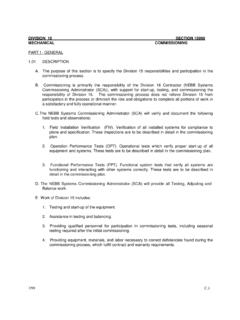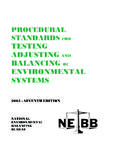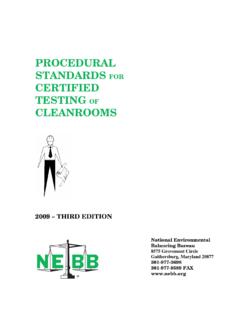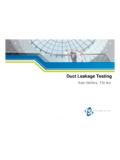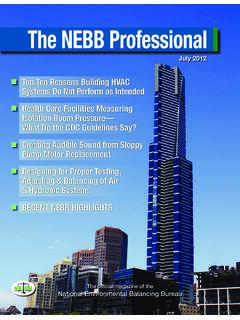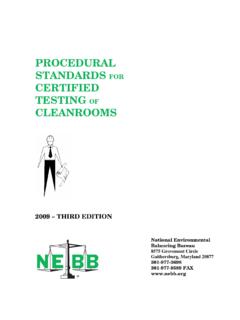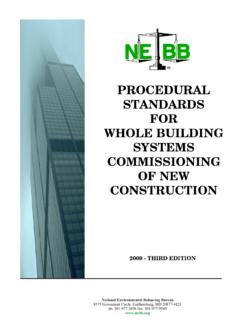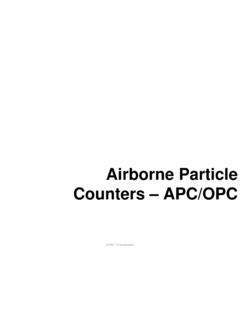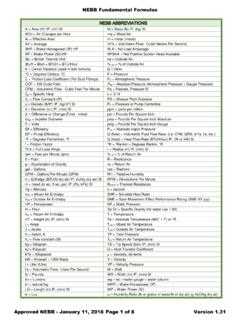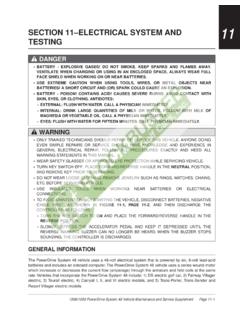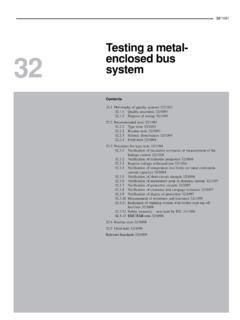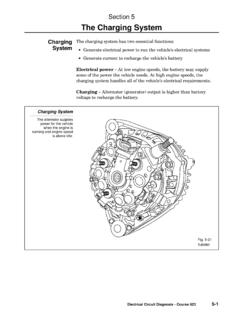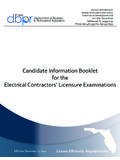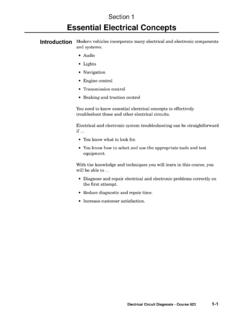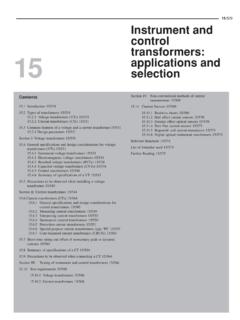Transcription of SECTION 15950 - TESTING, ADJUSTING, AND …
1 I SECTION 15950 - testing , adjusting , and balancing PART 1 - GENERAL RELATED DOCUMENTS Drawings and general provisions of the Contract, including General and Supplementary Conditions and Division 1 Specification Sections, apply to this SECTION . This SECTION includes testing , adjusting and balancing (TAB) to produce design flows for the following: 1. Air Systems: a. Constant-volume air systems. b. Dual-duct systems. c. Variable-air-volume systems. d. Multizone systems. e. Induction-unit systems. 2. Hydronic Systems a. Constant-flow systems b.
2 Variable-flow systems c. Primary-secondary systems 3. Kitchen hood systems 4. Fume hoods and Bio-Safety cabinet systems 5. Exhaust hood systems 6. Space pressurization 7. Shaft pressurization systems 8. Existing HVAC systems DEFINITIONS Accuracy: The accuracy of an instrument is the capability of that instrument to indicate the true value of a measured quantity. adjusting : adjusting is the varying of system flows by partially closing balancing devices, such as dampers and valves, and varying fan speeds to achieve optimum system operating conditions within design and installation limitations.
3 AHJ: The local governing Authority Having Jurisdiction over the installation. balancing : balancing is the methodical proportioning of air and hydronic flows through the system mains, branches, and terminal devices using acceptable procedures to achieve the specified airflow or hydronic flow within testing and design limitations. Calibrate: The act of comparing an instrument of unknown accuracy with a standard of known accuracy to detect, correlate, report, or eliminate by adjustment any variation in the accuracy of the tested instrument. NEBB TAB PROCEDURAL STANDARDS APPENDIX IIConformed Contract Documents: Current and complete documents.
4 Deficiency: Deficiency is considered any circumstance that adversely affects the specified balance of a device or system. Environmental Systems: Environmental Systems are systems that primarily use a combination of mechanical equipment, airflow, water flow and electrical energy to provide heating, ventilating, air conditioning, humidification, and dehumidification for the purpose of human comfort or process control of temperature and humidity. May: The word may is used to indicate a course of action that is permissible as determined by the NEBB Firm. NEBB Certified TAB Firm: A NEBB Certified TAB Firm is a firm that has met and maintains all the requirements of the National Environmental balancing Bureau for firm certification in testing , adjusting , and balancing and is currently certified by NEBB.
5 A NEBB Certified TAB Firm shall employ at least one NEBB Qualified TAB Supervisor in a full time management position. NEBB Certified TAB Report: The data presented in a NEBB Certified TAB Report accurately represents system measurements obtained in accordance with the current edition of the NEBB Procedural Standards for testing , adjusting , and balancing of Environmental Systems. A NEBB Certified TAB Report does not necessarily guarantee that systems included are balanced to design flows. Any variances from design quantities, which exceed NEBB tolerances or contract document tolerances, are noted in the test-adjust-balance report project summary.
6 NEBB Qualified TAB Supervisor: A NEBB Qualified TAB Supervisor is a full time employee of the firm in a management position who has successfully passed the supervisor level written and practical qualification examinations and maintains the Supervisor re-qualification requirements of NEBB. NEBB Qualified TAB Technician: A NEBB Qualified TAB Technician is a full time employee of the firm who has met the technician level experience requirements of NEBB and has successfully passed the technician level written and practical qualification examinations. A NEBB Qualified TAB Technician shall be supervised by a NEBB Qualified TAB Supervisor.
7 (Supervision is not intended to infer constant oversight. A NEBB Qualified TAB Technician is capable of performing assigned tasks with periodic supervision.) Precision: Precision is the ability of an instrument to produce repeatable readings of the same quantity under the same conditions. The precision of an instrument refers to its ability to produce a tightly grouped set of values around the mean value of the measured quantity. Procedure: A Procedure is defined as a specific set of tasks to be accomplished to achieve the defined result. Range: Range is the upper and lower limits of an instrument s ability to measure the value of a quantity for which the instrument is calibrated.
8 Resolution: Resolution is the smallest change in a measured variable that an instrument can detect. Shaft Pressurization System: A type of smoke-control system that is intended to positively pressurize stair and / or elevator shafts with outdoor air by using fans to keep smoke from contaminating the shafts during an alarm condition. NEBB TAB PROCEDURAL STANDARDS APPENDIX IIIS hall: The word shall is used to indicate mandatory requirements strictly to be followed in order to conform to the standard and procedures and from which no deviation is permitted.
9 Note: In the event unique circumstances prevent a required action from being fulfilled, a notation shall be included in the TAB report explaining the exception. For example, such notation could be one of the following: Not Available, Not Applicable, or Not Accessible. The simple notation N/A is not allowed. Should: The word should is used to indicate that a certain course of action is preferred but not necessarily required. Smoke-Control System: An engineered system that uses fans to produce airflow and pressure differences across barriers to limit smoke movement. Smoke-Control Zone: A space within a building that is enclosed by smoke barriers and is a part of a zoned smoke-control system.
10 Stair Pressurization System: A type of smoke-control system that is intended to positively pressurize stair towers with outdoor air by using fans to keep smoke from contaminating the stair towers during an alarm condition. System Effect: A phenomenon that can create undesired or unpredicted conditions that cause reduced capacities in all or part of a system. TAB Technician: A TAB Technician is an employee of a NEBB Certified TAB firm who assists a NEBB Qualified TAB Supervisor and / or a NEBB Qualified TAB Technician by performing TAB work in the field. (Supervision is not intended to infer constant oversight.)
